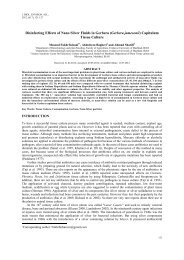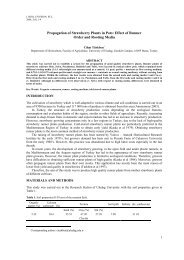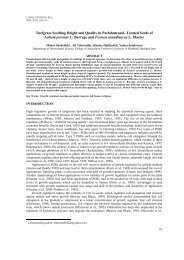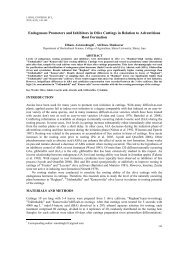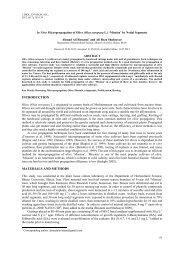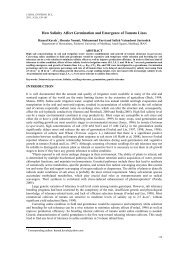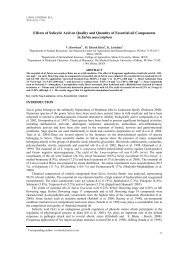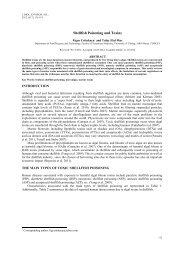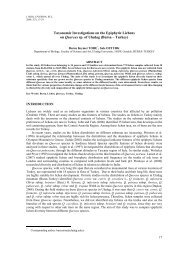Is HACCP a Difficult Food Safety System to Implement? HACCP ...
Is HACCP a Difficult Food Safety System to Implement? HACCP ...
Is HACCP a Difficult Food Safety System to Implement? HACCP ...
You also want an ePaper? Increase the reach of your titles
YUMPU automatically turns print PDFs into web optimized ePapers that Google loves.
J. BIOL. ENVIRON. SCI.,<br />
2013, 7(19), 33-38<br />
concluded that for the Mexican meat industry, investment in new equipment and microbiological tests of<br />
products accounted for most of the implementation and operational costs, respectively. Cala<strong>to</strong>re and Caswell<br />
(1999) reported from studies in the seafood industry that many companies failed <strong>to</strong> have a reliable costs and<br />
benefits estimation of <strong>HACCP</strong> implementation beforehand. They concluded that the uncertainty on costs and<br />
benefits estimations could be a major restrain for planning <strong>HACCP</strong> adoption by individual seafood companies.<br />
In the study of Bas et al. (2007), time and money were identified as the greatest barriers <strong>to</strong> improve food safety.<br />
As they reviewed, similar problems have been reported by other authors (Mortlock et al. 1999, Panisello and<br />
Quantick 2001, Panisello et al. 1999, Ward 2001). Youn and Sneed (2002) identified lack of financial resources<br />
<strong>to</strong> devote <strong>to</strong> food safety was the biggest resource barrier.<br />
As Salay and Caswell (1998) mentioned; <strong>HACCP</strong> implementation requires a complex interrelation<br />
among governments, industry and consumers but unfortunately, this responsibility is not always accomplished.<br />
Yapp and Fairman (2006) indicated a lack of trust in food safety legislation and enforcement officers. Hwang et<br />
al. (2001) found that Indiana school foodservice managers identified time <strong>to</strong> establish a <strong>HACCP</strong> program, time<br />
<strong>to</strong> run the program, and labor costs as being the three biggest obstacles. In addition, “lack of training funds, time<br />
<strong>to</strong> get used <strong>to</strong> running the <strong>HACCP</strong> program, and union problems” were the other identified obstacles. There is a<br />
big confusion between prerequisite programs and <strong>HACCP</strong> plan, their relations and how they should be managed<br />
(Vela & Fernandez, 2003). The main barrier <strong>to</strong> implementing a <strong>HACCP</strong> based food safety management system<br />
was the lack of prerequisite programs as concluded Bas et al. (2006).<br />
Giampaoli et al. (2002) conducted a national study and found three types of barriers: resource<br />
management, employee motivation, and employee confidence. Employees are nervous about taking food safety<br />
certification examinations and often are not comfortable with the change needed for implementation of a<br />
program like <strong>HACCP</strong>. Various studies have shown socio-psychological fac<strong>to</strong>rs <strong>to</strong> influence the implementation<br />
of <strong>HACCP</strong> programs (Ball et al. 2009, Ball et al. 2010, Clay<strong>to</strong>n and Griffith, 2008, Gilling et al. 2001, Hinsz et<br />
al. 2007). Taylor (2008) identifies other psychological barriers such as lack of agreement and lack of selfefficacy.<br />
Similarly, in the study of Garayoa et al. (2011) it was reported that attitude barriers due <strong>to</strong> a lack of<br />
educative courses, sessions or meetings, making it more difficult for workers <strong>to</strong> adhere <strong>to</strong> this system.<br />
Knowledge of the staff was found <strong>to</strong> be important for implementation. Vela and Fernandez (2003)<br />
concluded that; 46.6% of respondents claimed <strong>to</strong> have a good knowledge of <strong>HACCP</strong> while 6.6% admitted <strong>to</strong><br />
having a poor knowledge. Another study has demonstrated that an increase in the knowledge of a food handler<br />
does not necessarily change their food handling behavior and is dependent upon their attitude (Clay<strong>to</strong>n et al.<br />
2002). Panisello and Quantick (2001) identified constant turnover of employees as a barrier. Bas et al. (2007)<br />
concluded in their study that 91% of food business direc<strong>to</strong>rs agreed employees needed more training <strong>to</strong> improve<br />
food safety practices. According <strong>to</strong> their mention; their finding was consistent with the findings of Giampaoli et<br />
al. (2002), Hwang et al. (2001). As Ber<strong>to</strong>loni et al. (2007) mentioned that, <strong>HACCP</strong> can be hindered by lack of<br />
time, expertise, training, motivation, commitment and funding in SMEs. Hwang et al. (2001) also found that the<br />
availability of sanitation training had a positive relationship <strong>to</strong> implementing <strong>HACCP</strong>. Taylor (2001) considered<br />
the employment of experienced, technically qualified food staff as the most important fac<strong>to</strong>r influencing the<br />
implementation of <strong>HACCP</strong> system. Youn and Sneed (2002) identified lack of employee training was the biggest<br />
employee barrier. Lack of financial resources <strong>to</strong> devote <strong>to</strong> food safety was the biggest resource barrier. The<br />
survey results of Walker et al. (2003) in small-and medium-scale food producers underlined the lack of<br />
knowledge. Only 65% of producers kept any records. Their further results, based on questioning of managers,<br />
indicated that the basic lack of hygiene knowledge and understanding could prove <strong>to</strong> be a major barrier <strong>to</strong> the<br />
effective implementation of Bryan (1988) suggested that in the future the number of <strong>HACCP</strong> principles would<br />
increase from seven <strong>to</strong> ten or more. The ninth <strong>HACCP</strong> principle, according <strong>to</strong> him, would be education and<br />
training.<br />
In Turkey the barriers were found similar as reported worldwide. The study of Karaman et al. (2012)<br />
indicates that the most important barriers for food safety systems implementation in the Turkish dairy industry<br />
are due <strong>to</strong> insufficient funds, plant conditions, and knowledge about <strong>HACCP</strong> practices. According <strong>to</strong> a recent<br />
questionnaire study of Bas et al. (2007) in 115 food plants of Ankara, 87% of managers agreed that insufficient<br />
support from the authorities was the biggest problem. The purpose of their study was <strong>to</strong> determine barriers for<br />
36



